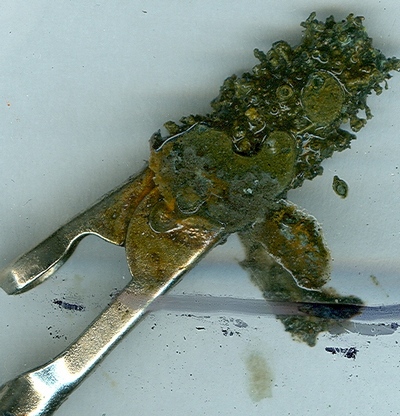REPATINATION with Reverse Electrolysis
Here's another attempt at repatination with reverse electrolysis. I'm going to try these 6 coins.
Reverse electrolysis is done by reversing the positive and negative leads for a short duration. I amgoing to use about 20 seconds. After each "burst", I'll move the alligator clips and repeat. I will do this 6 times, and see what happens.
I saved the water from my last two zapping sessions. I poured it into a gallon milk jug, and used the sink strainer to strain the bigger particles from the water, as I was pouring the water into the jug. The water has probably evaporated by 30%, since I forgot to put a lid on it.... so it should be a pretty concentrated mixture. The water is nearly black.
Here's what we have to begin with:

The two larger coins are totally stripped. All coins are somewhat porous, and I hope this process will help smooth it out. I have heard that some results indeed filled in the porousness. The biggest drawback of zapping for me is after the patina loss, pits and porousness is revealed. I won't zap a coin unless I feel that no other means would remove the encrustation. Let's see what happens. (This experiment idea courtesy of CoinZappers).
After the first two sessions.... coins are becoming a light blue... close to this background color. Very odd, not what I expected at all. After the third session, it seems that not much is being attached to the coin. I am going to run the last 3 sessions for about 2 minutes each. After the fourth session, the coins are much more bluer. But it's blue! *scratches head* The alligator clips look like pieces of coral too...

For the final session, I switched it from 6v 6amp to 12v 2amp, since my meter was barely registering any current. Well, the result is certainly not what I expected, nor what I had hoped for. The coins do appear smoother though. The brownish spots are mud I believe. It looks like mud at least. The smoothing factor is nice, but the coloring is just wrong. Hmmm....
The "patina" doesn't seem to rub off, after I let them air dry. I'm not sure if I should risk trying to remove the mud or not. After drying, the coins look quite a bit more green than blue, as they did while zapping. I didn't throw them into vinegar, as Jerry of CZ suggests... I hate the smell of vinegar and can actually throw up by just smelling it. Not sure if it makes a difference in the coloring. The two large, totally stripped coins came out better than the Ants.
I'll have to ask the experts on CZ on why they turned blue; and why I have mud on my coins now. Perhaps I need to wipe the clips off after each session.

Hmmm, very interesting... I applied Renwax to one of the coins and it turned to a medium brown. The green was lost. The scan looks rather rough though. It's not quite as rough as the scan, but I' thinking that it may be more rough than it was initially.
